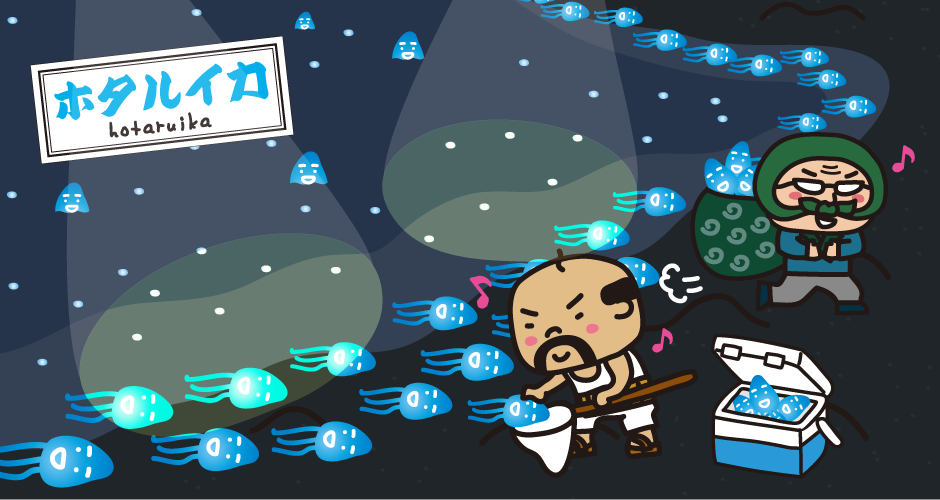If you think that you can see firefly squid anytime you go there, you will be disappointed with the gap between your expectation and the reality. So, please do not hesitate to go “HOTARUIKA Museum (firefly squid museum)”.
Every year from March to May, large numbers of firefly squid, glowing blue and white, are washed up in the surf by the waves along the coast of Toyama Bay from Toyama City to Uozu City, centering on Namerikawa City, Toyama Prefecture. This scene is known as the “Hotaruika no Gunyuukaimen – Firefly squid swarming sea surface,” and is designated as a special natural monument in Japan. Incidentally, firefly squid themselves have not protected species, so it is okay to catch and eat firefly squid.
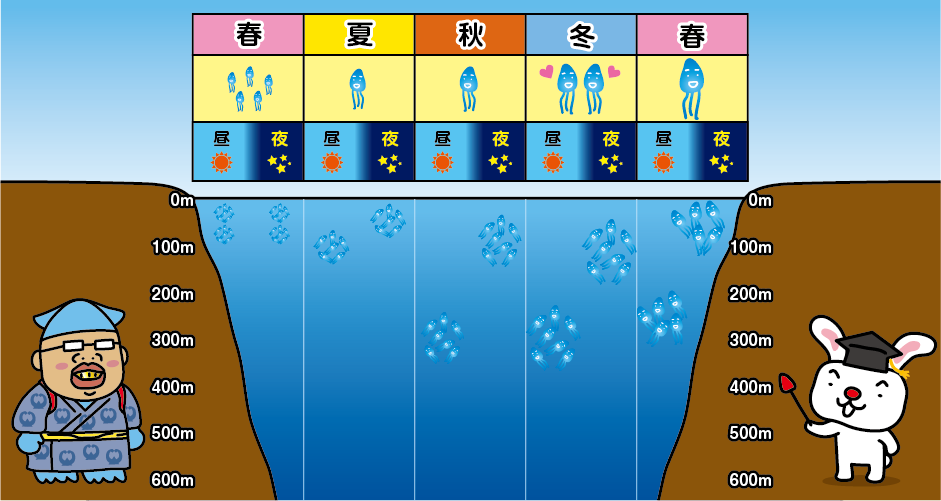
Firefly squid are annual migratory fish, small squid weighing 10 grams, 4 cm to 5 cm for males, and 5 cm to 7 cm for females, whose entire body emit a bluish-white light when stimulated. They usually live in deep water at depths of 200m to 300m, but at night they surface at depths of 30m to 100m in search of food. They gather in Toyama Bay during the spawning season from March to May.
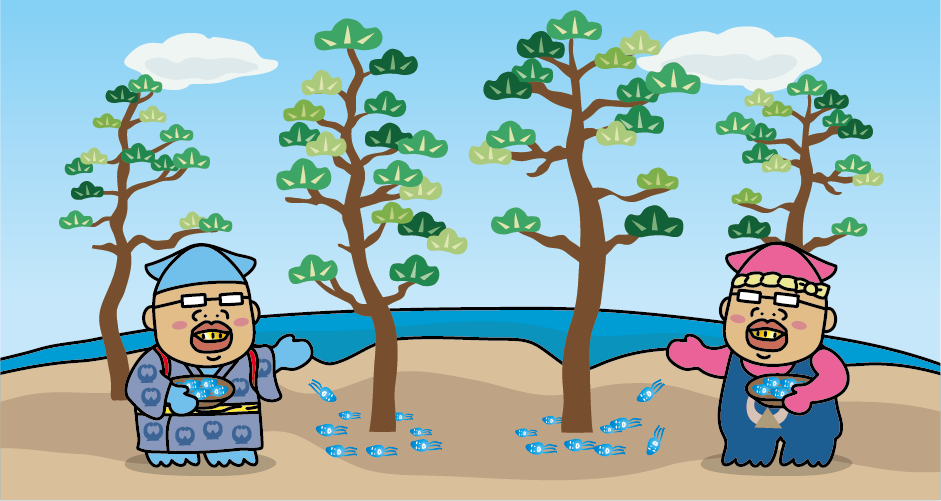
Long time ago in Toyama, people used firefly squids as fertilizers for pine trees so people called them “matsuika (pine tree squid)”. Since 1905, its name became “firefly squid” because Dr. Shozaburo Watase of University Tokyo who studied ecology of firefly named it as “a squid that emit light like firefly”.
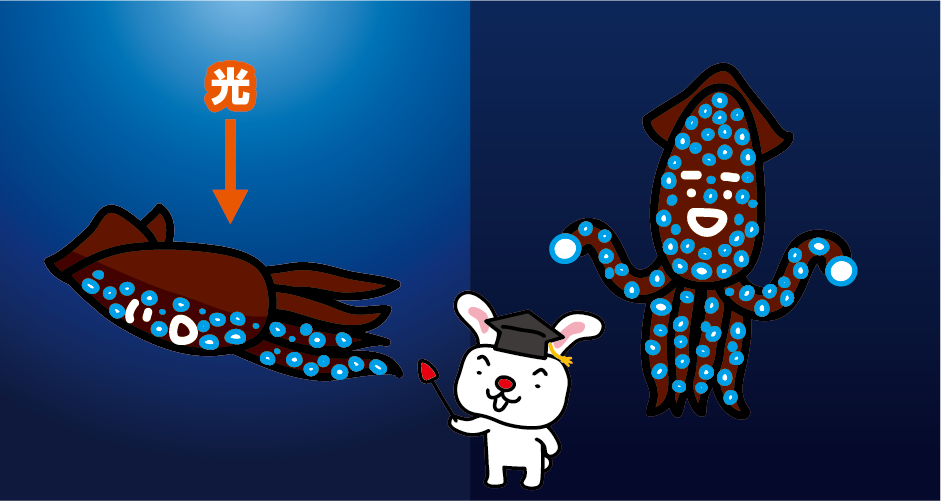
Firefly squid emit light through a chemical reaction between a luminescent substance (Luciferin) and a luminescent enzyme (Luciferase). This light is called “cold light” because it has no heat. This is almost the same mechanism by which fireflies emit light. Firefly squid have luminescent organs on their entire skin, arms, and around their eyes, each with a different role, but firefly squid emit light for two main reasons. First, when they come into contact with enemies, the tips of their two arms (the fourth arm) emit a strong light to intimidate them. Second, firefly squid are brown when swimming in the deep sea, but when they rise to the surface, the light shining into the sea causes their shadow to appear, and to prevent them from being targeted by enemies from below, they camouflage themselves by emitting light on their ventral side. (There are about 1000 luminous organs on the ventral side, but very few luminous organs on the dorsal side.)
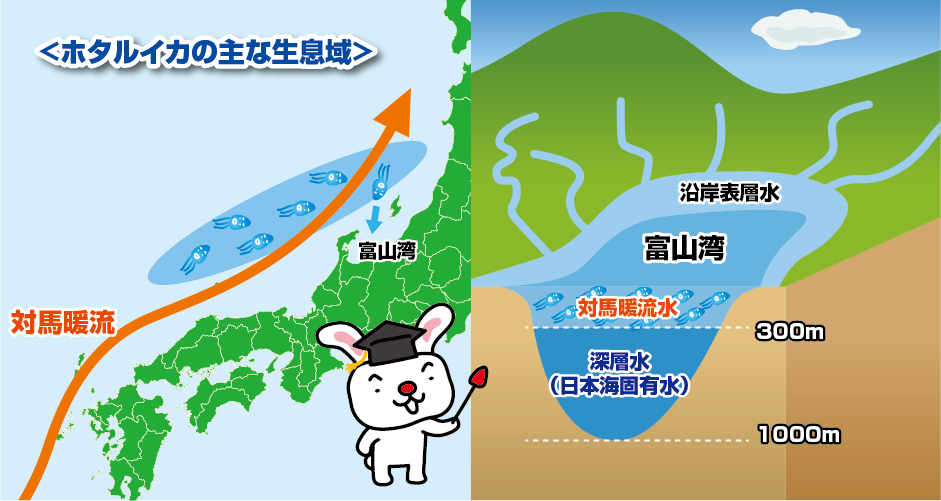
Firefly squid are widely distributed in the seas around Japan but are mainly found in the waters off the San’in region and off the Akita region of the Sea of Japan. One theory is that the waters off the San’in region are thought to be the spawning grounds of firefly squid. Firefly squid hatch in early spring and move northward on the Tsushima Warm Current, becoming adults from off the Noto region to off the Akita region, and then move southward to spawn off the San’in region the following spring. It is supposed that firefly squid that split off from the main current enter Toyama Bay during this southward migration, and Toyama Bay is the only place in the world where you can see the sight of large numbers of firefly squid rushing into the bay (the “Hotaruika no Gunyuukaimen – Firefly squid swarming sea surface”). Incidentally, firefly squid spawn at night, rising to the surface from a depth of about 200 meters in Toyama Bay to the coast. Most of the firefly squid that come to the surface are females. Males mate in the deep sea and live out their lives. (Firefly squid’s mating season is from November to February.)
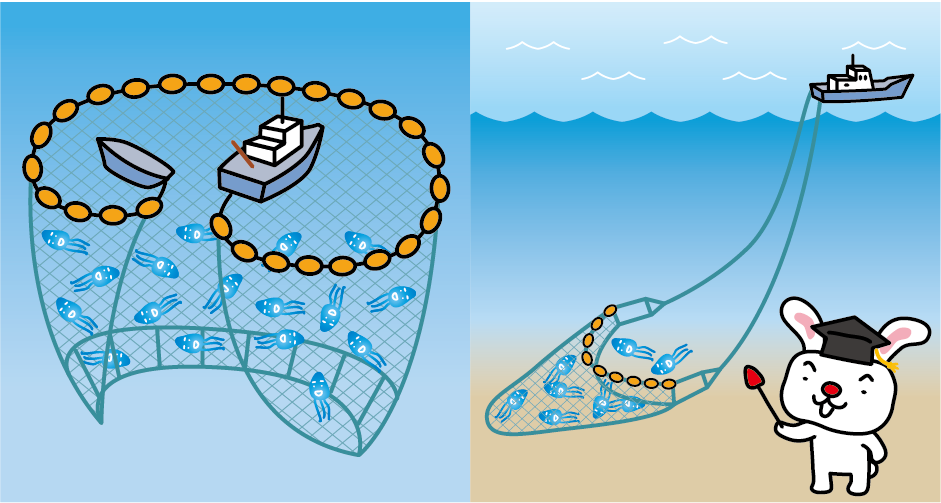
Firefly squid are a well-known mystery of Toyama Bay, but the catch of firefly squid is actually larger in Hyogo Prefecture than in Toyama Prefecture. This is due to the difference in fishing methods. In Toyama Prefecture, firefly squid that surface in Toyama Bay to spawn are caught in fixed fishing nets, whereas in Hyogo Prefecture, firefly squid swimming at a depth of about 200 meters are caught in bottom trawling nets. Firefly squid caught in Toyama Prefecture are traded at a higher price in the market because they are only full-figured females that have stored nutrients for spawning.
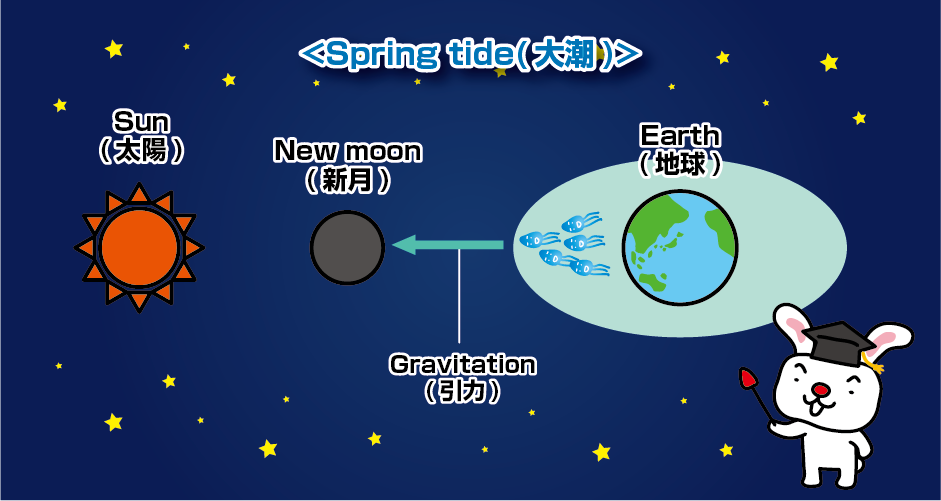

Firefly squid that have washed up are known as “Hotaruika no Minage – Firefly squid oneself throwing” (meaning firefly squid suicide). It is not always easy to see even from March to May in Toyama Bay. According to locals, large numbers of firefly squid may be washed up in the surf, depending on the following conditions.
-New Moon and two days before and after, high tide from midnight to dawn
-Calm waves and land breezes (southerly winds in the case of Toyama Bay)
*When land breezes blow, upwelling currents occur in Toyama Bay, causing deep water to rise up near the surface and deep-sea creatures to rise to the surface together.
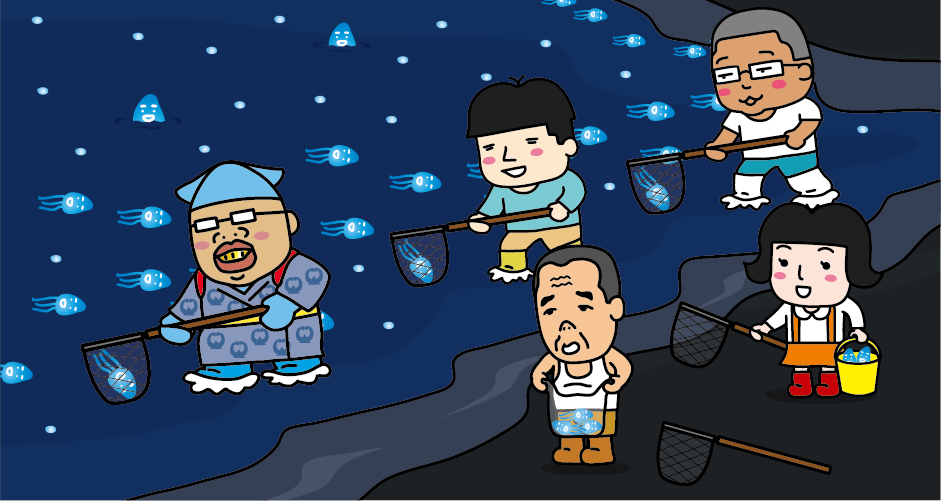
Incidentally, firefly squid that have washed up on the beach are not suitable for eating because they are chewing sand. If edible, catch firefly squid floating on the surface of the sea before they are washed up on the beach by scooping them up with Tamo nets or something like that.
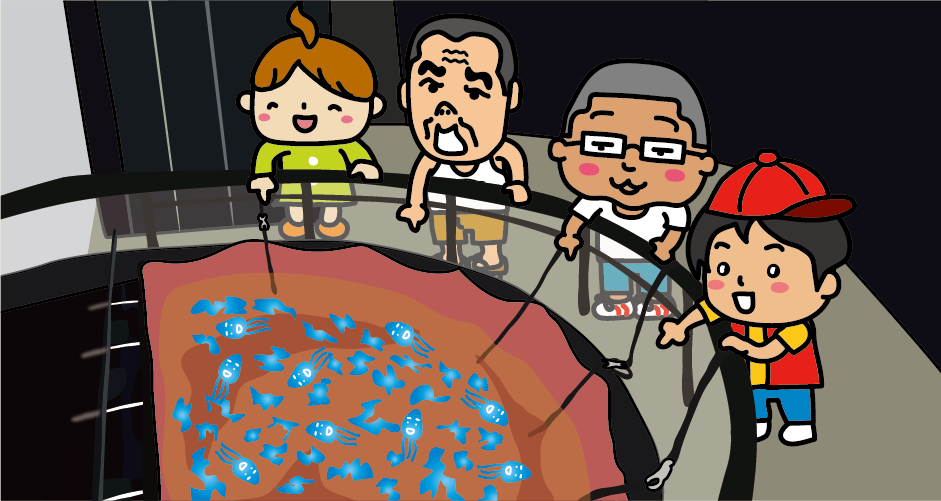
“HOTARUIKA museum” is a museum that its theme is firefly squid and its building is shaped as a body of firefly squid. From the middle of March to the end of May, in the season of firefly squid fishing season, the lightning show of live firefly squid is held and you can touch firefly squid directly with your bare hands. (During the off-season, you can watch the light emitting image of firefly squid by LED lights.)
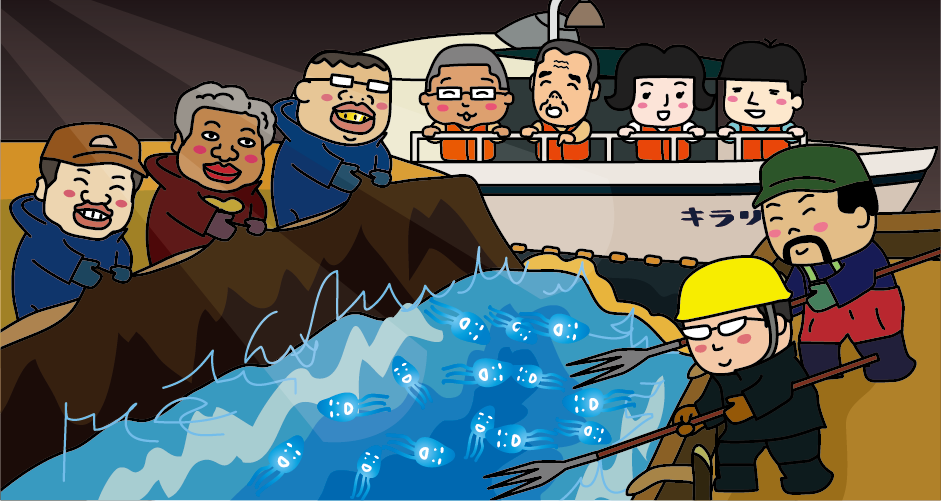
“Firefly squid tourism at sea” will be held every year from the middle of April to the early May. From Namerikawa fishing port, sightseeing ships will sail before daybreak, and you can observe firefly squid fishing and how firefly squid emit light at a fishing spot.
Access to HOTARUIKA Museum (Firefly Squid Museum)
[Railway]
From Tokyo
It takes about 2 hours from JR Tokyo Station to JR Toyama Station by Hokuriku Shinkansen.
From Osaka
It takes about 1 hour and 30 minutes from JR Osaka Station to JR Tsuruga Station by limited express train. Transfer to the Hokuriku Shinkansen at JR Tsuruga Station, and it takes about 1 hour from JR Tsuruga Station to JR Toyama Station.
[Airplane]
It takes about 1 hour from Haneda Airport to Toyama Airport. It takes about 25 minutes from Toyama Airport to JR Toyama Station by shuttle bus.
Transfer to the Ainokaze Toyama Railway at JR Toyama Station to get to Namerikawa Station on the Ainokaze Toyama Railway in about 15 minutes. About 10 minute-walk from Namerikawa Station on the Ainokaze Toyama Railway.
